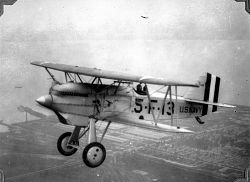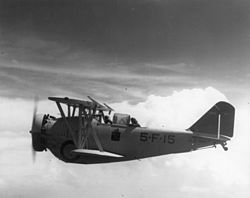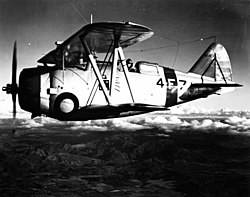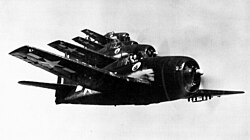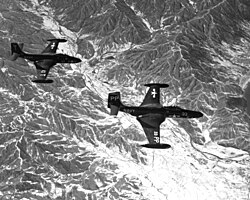
VFA-31 or Strike Fighter Squadron 31 is known as the Tomcatters, callsign "Felix", a United States Navy strike fighter squadron stationed at Naval Air Station Oceana flying the F/A-18E Super Hornet. The Tomcatters are the second oldest Navy Fighter Attack squadron operating today.

Fighter Squadron 61 (VF-61), the Jolly Rogers, was a fighter squadron of the United States Navy. Originally established as VF-17 on 1 January 1943, it was redesignated as VF-5B on 15 November 1946, and then later as VF-61 on 28 July 1948. It was disestablished on 15 April 1959. It was the first navy squadron to be designated VF-17.

Strike Fighter Squadron 11 (VFA-11) is a United States Navy strike fighter squadron stationed at Naval Air Station Oceana, Virginia, United States. The squadron was established in 1950 and is nicknamed "Red Rippers". VFA-11 is equipped with the Boeing F/A-18F Super Hornet and currently assigned to Carrier Air Wing One.

Fighter Squadron 111 (VF-111), also known as the Sundowners, was a fighter squadron of the United States Navy. Originally established as Fighter Squadron 11 (VF-11) on 10 October 1942, it was redesignated as VF-11A on 15 November 1946, redesignated as VF-111 on 15 July 1948 and disestablished on 19 January 1959. On 20 January, another squadron, VF-111 (1956-95) then assumed the designation until its de-establishment in 1995. In November 2006, VFC-13 Detachment Key West was redesignated as VFC-111, taking on the Sundowner insignia and callsign.

Fighter Squadron 194 (VF-194) was an aviation unit of the United States Navy. It was originally established as VF-91 on 26 March 1952, redesignated VF-194 on 1 August 1963 and disestablished on 1 March 1978. It was the third US Navy squadron to be designated VF-194.

Fighter Squadron 53, or VF-53Iron Angels was an aviation unit of the United States Navy in service from 20 July 1950 to 29 January 1971. Originally established as reserve squadron VF-721 on 20 July 1950, it was redesignated as VF-141 on 4 February 1953 and then redesignated as VF-53 on 15 October 1963. The squadron was disestablished on 29 January 1971. It was the fourth US Navy squadron to be designated as VF-53.

Light Photographic Squadron 62 (VFP-62) was an aviation unit of the United States Navy in service from 1949 to 1968. The squadron provided a detachment of reconnaissance planes for each of the carrier air wings of the U.S. Atlantic Fleet.

VA-106 was an Attack Squadron of the U.S. Navy. Originally established as Bomber-Fighter Squadron Seventeen (VBF-17) on 2 January 1945, it was redesignated Fighter Squadron Six B (VF-6B) on 15 November 1946, redesignated VF-62 on 28 July 1948, redesignated Attack Squadron 106 (VA-106) on 1 July 1955, it was disestablished on 7 November 1969. It was the second US Navy squadron to be designated VA-106.

VA-172 was an Attack Squadron of the U.S. Navy. It was established as Bomber Fighter Squadron VBF-82 on 20 August 1945, redesignated as Fighter Squadron VF-18A on 15 November 1946, as VF-172 on 11 August 1948, and as VA-172 on 1 November 1955. The squadron was disestablished on 15 January 1971. Its nickname was the Checkmates from 1946-1950, and the Blue Bolts thereafter.

VA-34, nicknamed the Blue Blasters, was an Attack Squadron of the U.S. Navy. The squadron was established as Fighter Squadron VF-20 on 15 October 1943, redesignated as VF-9A on 15 November 1946, as VF-91 on 12 August 1948, and as VF-34 on 15 February 1950. It was finally redesignated VA-34 on 1 July 1955. The squadron was disestablished on 1 June 1969. It was the second squadron to bear the VA-34 designation, the first one having been renamed VA-35 in 1950.

Attack Squadron 12 (VA-12), also known as the "Flying Ubangis" or "Clinchers", was an attack squadron of the United States Navy active during the Cold War. From their home port at Naval Air Station Cecil Field in Florida, the squadron made more than thirty major overseas deployments aboard aircraft carriers, primarily flying A-4 Skyhawk and later the A-7E Corsair II, including two combat tours in the Vietnam War.

VF-13 was a Fighter Squadron of the U.S. Navy, established on 2 August 1948 and disestablished on 1 October 1969. It was the second squadron to be assigned the VF-13 designation, the original VF-13 Black Cats was established on 2 November 1943 and disestablished on 20 October 1945.
VF-43 was a fighter squadron of the U.S. Navy. The squadron was originally established as Fighter Squadron 74A (VF-74A) on 1 May 1945, it was redesignated Fighter Squadron 74 (VF-74) on 1 August 1945, redesignated VF-1B on 15 November 1946, redesignated VF-21 on 1 September 1948, redesignated as Attack Squadron 43 (VA-43) Challengers on 1 July 1959 and Fighter Squadron 43 (VF-43) on 1 June 1973. It was disestablished on 1 July 1994.

Fighter Squadron 52 or VF-52 was an aviation unit of the United States Navy. Originally established as Bombing Fighting Squadron 5 (VBF-5) on 8 May 1945, it was redesignated Fighting Squadron 6A (VF-6A) on 15 November 1946, redesignated as Fighter Squadron 52 (VF-52) on 16 August 1948 it was disestablished on 23 February 1959. It was the third US Navy squadron to be designated as VF-52.
Fighter Squadron 171 or VF-171 was an aviation unit of the United States Navy. Originally established as Fighter Squadron 82 (VF-82) on 1 April 1944, it was redesignated VF-17A on 15 November 1946, redesignated as VF-171 on 11 August 1948 and disestablished on 15 March 1958.

Fighter Squadron 22 or VF-22 was an aviation unit of the United States Navy. Originally established as Bombing Fighting Squadron 74A (VBF-74A) on 1 May 1945, it was redesignated VBF-74 on 1 August 1945, redesignated as VF-2B on 15 November 1946, redesignated as VF-22 on 1 September 1948, it was disestablished on 6 June 1958.

Fighter Squadron 82 or VF-82 was an aviation unit of the United States Navy. Originally established as Reserve Squadron VF-742 it was called to active duty during World War II and later recalled on 2 February 1951, redesignated VF-82 on 4 February 1953, it was disestablished on 15 April 1959. It was the third US Navy squadron to be designated VF-82.
Fighting Squadron 6 or VF-6 was an aviation unit of the United States Navy. Originally established as Combat Squadron 4 on 23 September 1921, it was redesignated VF-2 on 1 July 1922, redesignated VF-2B on 19 March 1923, redesignated VF-6B on 1 January 1927, redesignated VF-6 on 1 July 1927, redesignated VB-2B on 1 July 1928, redesignated VF-6B on 1 July 1930, redesignated VF-3 on 1 July 1937, redesignated VF-6 on 15 July 1943 and disestablished on 29 October 1945.
Fighting Squadron 72 or VF-72 was an aviation unit of the U.S. Navy, originally established as VF-7 on 1 July 1939, it was redesignated as VF-72 on 19 November 1940 and disestablished on 29 March 1943.
Fighting Squadron 9 or VF-9 was an aviation unit of the U.S. Navy, originally established on 1 March 1942, it was disestablished on 28 September 1945.
